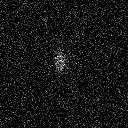OVERVIEW
Speckle interferometry, once the sole province of professional astronomers, has expanded to include many amateur and undergraduate and even high school student observers and analysts. This expansion is due to the increased availability of high-speed CCD cameras, powerful PCs, PC-friendly software, and opportunities for publication.
Speckle interferometry overcomes normal atmospheric seeing conditions by taking a series (often thousands) of short-exposure images (typically 10-60 milliseconds) which “freeze out” the usual atmospheric smearing. Speckle interferometry only works within the isoplanatic patch where atmospheric distortions are correlated—typically less than 10 arc seconds. Analyzing speckle images works best when observing geometrically simple objects such as close visual double stars, binary asteroids, Pluto and Charon, Jupiter’s moons, and the diameters of large nearby stars.
